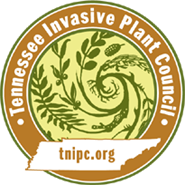Fallopia japonica (Houtt.) Ronse Decr.
Fallopia japonica (Houtt.) Ronse Decr.Fleeceflower, Japanese Knotweed, Mexican Bamboo, Polygonum cuspidatum Seib. & Zucc.
| Threat Level | Category |
|---|---|
| Established | Forb/Herb |
|
Similar Species May be confused with the following native and/or non-native species. Landscape Alternatives lists native horticultural substitutes |
Polygonum spp. Landscape Alternatives |
|---|

Description
Height
Japanese knotweed can grow 3-10 feet (1-3 m) tall.Stem
The stout stems are glaucous and erect, swelling at leaf axils.Leaves
The broadly ovate leaves are petiolate, truncate to somewhat triangular, and pointed at the tip. Length is generally 2-6 inches (5-15 cm) long, and 2-5 inches (5-12 cm) wide, with a prominent basal angle.Flowers
Minute greenish-white flowers appear in axillary panicles with three styles and minute stigmas. Outer sepals are narrowly winged along the midrib. Blooms August-September.Fruit
The fruiting calyxes are wing-angled, 0.3 inch long (8-9 mm). Achene is triangular, shiny, 0.1-0.15 inch (3-4 mm) long.Images
Photo: Tom Heutte, USDA Forest Service, Bugwood.orgMore images of Polygonum cuspidatum
Life History
Japanese knotweed, commonly known as crimson beauty, Mexican bamboo, Japanese fleece flower, or Reynoutria, was probably introduced to the U.S. as an ornamental. Initially useful for erosion control, as an ornamental, and for landscape screening, Japanese knotweed spreads quickly to form dense thickets that can alter natural ecosystems or interfere with landscaping. It is a semi-woody, bushy perennial and a member of the Polygonaceae (Knotweed) family.Knotweed spreads rapidly from stout long rhizomes. Seeds are distributed by water in floodplains, transported with fill dirt, and to a lesser extent are wind-blown. Populations escaped from neglected gardens, and discarded cuttings are common urban paths of distribution. Once established, populations are quite persistent and can outcompete existing vegetation. This plant is a popular ornamental, and many cultivated varieties are produced by the nursery industry. Varieties may be difficult to distinguish, but most share the same invasive characteristics and will respond to the same treatment as the parent plant.
Habitat
Japanese knotweed can tolerate a variety of adverse conditions including full shade, high temperatures, high salinity, and drought. It is found near water sources, in low-lying areas, waste places, utility rights of way, and around old homesites. It can quickly become an invasive pest in natural areas after escaping from cultivated gardens. It poses a significant threat to riparian areas, where it can survive severe floods. It is rapidly colonizing scoured shores and islands.Origin and Distribution
Japanese knotweed, native to Japan, was introduced into the United States prior to 1890. By the turn of the century, it was established in the eastern United States and was reported naturalized around Philadelphia, PA, Schenectady, NY, and Atlantic Highlands, NJ. Knotweed was collected in the Tennessee region in the 1940s and is now found throughout the state. In 1966, it was considered "one of the most persistent and aggressive of all perennial weeds." Current distribution is from Newfoundland to Ontario, in many parts of the north and southeastern U.S., and west to Minnesota and Iowa. Other states where invasive: AK, WA, OR, MO, GA, WI, MI, IN, OH, WV, VA, NC, MD, NJ, PA, NY, CT, RI, DE, MA, NH, VT, ME. Federal or state listed as noxious weed, prohibited, invasive or banned: AL, CA, CT, MA, NH, OR, VT, WA.Sources: Information on this plant page derived primarily from the Tennessee Management Manual.
Management Recommendations
Mechanical Control
Grubbing: This method is appropriate for small initial populations or environmentally sensitive areas where herbicides cannot be used. Using a pulaski or similar digging tool, remove the entire plant including all roots and runners. Juvenile plants can be hand-pulled depending on soil conditions and root development. Any portions of the root system not removed will potentially resprout. All plant parts, including mature fruit, should be bagged and disposed of in a trash dumpster to prevent reestablishment.Herbicidal Control
Cut Stump Treatment
Use this method in areas where vines are established within or around non-target plants or where vines have grown into the canopy. This treatment remains effective at low temperatures as long as the ground is not frozen.Glyphosate: Cut the stem 5 cm (2 in) above ground level. Immediately apply a 25% solution of glyphosate and water to the cross-section of the stem. A subsequent foliar application of glyphosate may be required to control new seedlings and resprouts.
Triclopyr: Cut the stem 5 cm (2 in) above ground level. Immediately apply a 25% solution of triclopyr and water to the cross-section of the stem. A subsequent foliar application may be necessary to control new seedlings.
Foliar Spray Method
Use this method to control large populations. It may be necessary to precede foliar applications with stump treatments to reduce the risk of damaging non-target species.Glyphosate: Apply a 2% solution of glyphosate and water to thoroughly wet all foliage. Do not apply so heavily that herbicide will drip off leaves. The ideal time to spray is after surrounding vegetation has become dormant (October-November) to avoid affecting non-target species. A 0.5% non-ionic surfactant is recommended in order to penetrate the leaf cuticle, and ambient air temperature should be above 65°F.
Triclopyr: Apply a 2% solution of triclopyr and water to thoroughly wet all foliage. Do not apply so heavily that herbicide will drip off leaves. The ideal time to spray is after surrounding vegetation has become dormant (October-November) to avoid affecting non-target species. A 0.5% non-ionic surfactant is recommended in order to penetrate the leaf cuticle, and ambient air temperature should be above 65°F.
